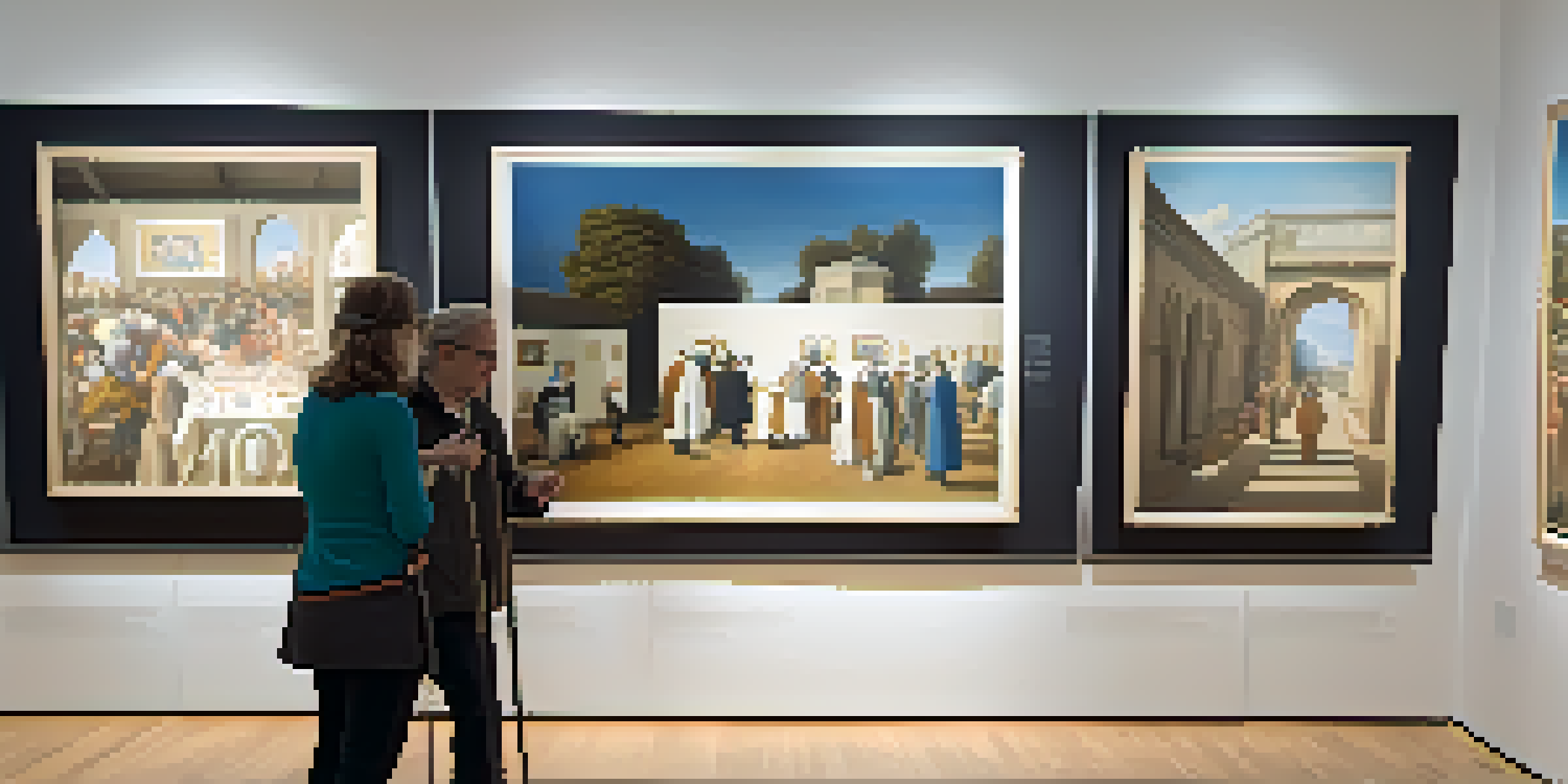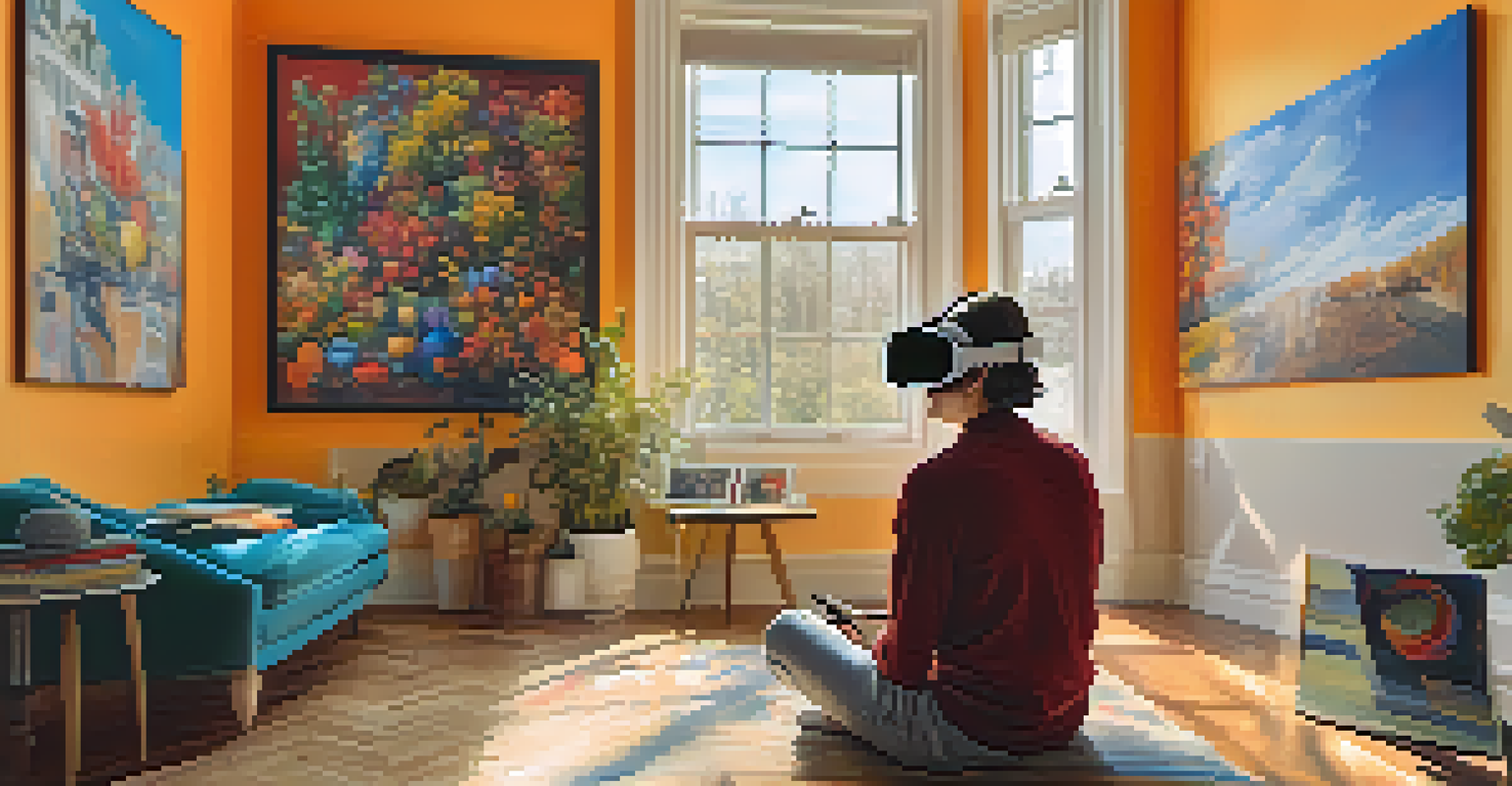The Role of Technology in Making Art Accessible

Understanding Accessibility in the Art World
Accessibility in art means ensuring everyone can experience and enjoy artistic expressions, regardless of their physical or cognitive abilities. This includes making museums, galleries, and performances welcoming for individuals with disabilities. The goal is to remove barriers that prevent full participation in the arts, fostering an inclusive environment for all.
Art is not what you see, but what you make others see.
Traditionally, many forms of art have been limited to those who could physically attend venues or engage with artworks in person. However, as society evolves, so too does the understanding of who gets to participate in the creative landscape. The push for accessibility not only benefits individuals with disabilities but enriches the cultural fabric as a whole.
With the rise of technology, the art world is beginning to embrace innovative solutions that enhance accessibility. From virtual reality experiences to audio descriptions, technology plays a crucial role in expanding who can enjoy and engage with art. This shift is transforming how we think about access and inclusion in the arts.
Virtual Reality: A New Dimension of Art Experience
Virtual reality (VR) offers immersive experiences that allow users to step into a digital artwork, breaking the confines of traditional viewing. This technology has proven beneficial for individuals who may have mobility challenges, allowing them to explore art galleries and exhibitions from the comfort of their homes. Imagine walking through the Louvre without ever leaving your living room!

In addition to physical access, VR can cater to diverse learning styles and preferences, providing an alternative way to engage with art. For instance, users can interact with 3D models, offering a tactile experience that might be more accessible than viewing a painting on a wall. This interactivity fosters a deeper connection to the art and enhances understanding.
Art Accessibility Benefits Everyone
Making art accessible enriches cultural experiences for all, not just those with disabilities.
Moreover, VR experiences can be tailored to accommodate various disabilities, ensuring that everyone can enjoy the beauty of art. By using technology to create inclusive environments, we can celebrate the unique perspectives and talents of all individuals, regardless of their physical limitations.
Using Augmented Reality to Enhance Art Engagement
Augmented reality (AR) layers digital content over the real world, offering fresh ways to experience art. For instance, a user could point their smartphone at a painting and see additional information, context, or even animations that bring the art to life. This can greatly benefit individuals who are visually impaired by providing auditory descriptions and enhancing their understanding of the artwork.
The arts are not a luxury, but a necessity for the human spirit.
AR can also make art more interactive and engaging for everyone. Imagine a family visiting a museum where kids can unlock fun facts or games related to each artwork simply by using their devices. This gamified approach not only entertains but also educates, making art more accessible to younger audiences and those unfamiliar with artistic concepts.
The beauty of AR lies in its ability to create personalized experiences, catering to individual needs. Artists and curators can utilize this technology to remove barriers and ensure that their work resonates with a wider audience, fostering a love for the arts in diverse communities.
Online Platforms: Expanding Access to Art Collections
The internet has revolutionized how we access art, with countless museums and galleries offering virtual tours and online exhibitions. This shift has made it possible for anyone, anywhere, to explore renowned collections without the need for travel. Whether it's viewing Van Gogh's masterpieces or contemporary installations, the virtual world opens doors previously thought locked.
These online platforms often come equipped with accessibility features such as screen readers, captions, and translated content, ensuring that people with disabilities can fully engage with the art. By breaking geographic and physical barriers, these platforms are democratizing art access, allowing individuals who may never visit in person to appreciate and learn about important works.
Technology Enhances Art Engagement
Innovative tools like VR and AR create immersive and interactive ways for diverse audiences to experience art.
Furthermore, the convenience of online access means that people can explore art at their own pace and comfort. This flexibility is particularly beneficial for those who may feel overwhelmed in crowded spaces, allowing for a more personal connection to the art.
Assistive Technologies: Bridging the Gap in Art Accessibility
Assistive technologies are tools designed to help individuals with disabilities engage with the world around them, and they play a vital role in making art accessible. For example, tactile graphics can be used to create raised images of famous paintings for visually impaired individuals, allowing them to 'feel' the art. This hands-on approach can lead to a deeper appreciation for artistic techniques and styles.
Additionally, audio guides and apps can provide detailed descriptions of artworks, enhancing the viewing experience for those who may struggle with visual content. This kind of technology empowers people to explore and appreciate art on their own terms, ensuring that no one is left behind in the creative conversation.
By integrating assistive technologies into art spaces, institutions can create inclusive environments that celebrate diversity. These tools not only enhance accessibility but also foster a sense of belonging, making everyone feel valued in the artistic community.
Social Media: Amplifying Diverse Artistic Voices
Social media platforms have become powerful tools for artists and audiences alike, providing a space for diverse voices to be heard. Artists can showcase their work to a global audience without the barriers of traditional galleries, while audiences can discover new talents and perspectives. This accessibility helps to democratize the art world, empowering individuals from all backgrounds to share their creativity.
Moreover, social media fosters community engagement and connection among artists and art lovers. Through hashtags and online discussions, people can share their experiences and insights, creating a sense of belonging and support. This interconnectedness can lead to collaborations and opportunities that might not have been possible in a more isolated environment.
Social Media Amplifies Artistic Voices
Social media democratizes the art world, allowing artists from all backgrounds to share their work and connect with audiences globally.
However, it's important to recognize that not everyone has equal access to technology or social media platforms. As we celebrate the benefits of these tools, we must also advocate for greater digital equity, ensuring that all artists can participate in the conversation and share their unique stories with the world.
The Future of Art Accessibility: Embracing Innovation
As technology continues to evolve, the potential for making art even more accessible is limitless. Innovations such as artificial intelligence and machine learning could lead to new ways of interpreting and interacting with art, further breaking down barriers. For instance, AI could analyze audience preferences and tailor experiences to meet diverse needs, making art appreciation more personalized and engaging.
Additionally, as we see more collaborations between artists and technologists, the art world will likely become a more inclusive space. Artists will have access to tools that allow them to create works that specifically consider accessibility, ensuring that their art resonates with everyone. This forward-thinking approach will help to shape a more equitable future.

Ultimately, the role of technology in making art accessible is about more than just tools—it's about fostering a culture of inclusivity and understanding. By embracing innovation, we can create an art world that celebrates diversity and invites everyone to experience the beauty of creativity.